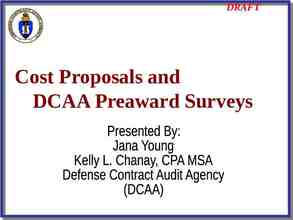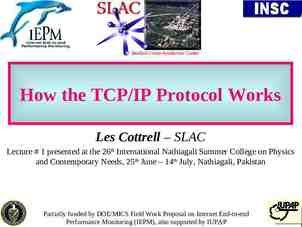1 Digging into Earth Sciences in the Preschool Years Volume 3,
55 Slides3.91 MB

1 Digging into Earth Sciences in the Preschool Years Volume 3, Science Domain 2015 California Department of Education (CDE) with the WestEd Center for Child & Family Studies, California Preschool Instructional Network (CPIN). (05/2015)

2 Outcomes Today we will: Interact with earth materials Read the Earth Sciences strand from the Preschool Learning Foundations (PLF, Vol. 3) Connect the PLF reading to strategies from the Earth Sciences strand of the Preschool Curriculum Framework (PCF, Vol. 3) Identify strategies specifically supportive to dual language learners in the earth sciences Practice utilizing UDL strategies to enhance opportunities to support all children in the earth sciences Plan an activity to apply all ideas from the day with engaging family strategies 2015 California Department of Education (CDE) with the WestEd Center for Child & Family Studies, California Preschool Instructional Network (CPIN). (05/2015)

3 Of all the paths you take in life, make sure some of them are dirt. - John Muir Beautiful Life 2015 California Department of Education (CDE) with the WestEd Center for Child & Family Studies, California Preschool Instructional Network (CPIN). (05/2015)

4 Natural Environment Children’s direct contact with the natural environment enhances their connection to nature and constitutes an essential and critical dimension of healthy development (Kellert 2002). PLF, Vol.3, p. 59 2015 California Department of Education (CDE) with the WestEd Center for Child & Family Studies, California Preschool Instructional Network (CPIN). (05/2015)

5 Two California Department of Education Resources Wha t How 2015 California Department of Education (CDE) with the WestEd Center for Child & Family Studies, California Preschool Instructional Network (CPIN). (05/2015)

6 Early Learning Development System Framework: Science Domain Foundations: Science Domain 2015 California Department of Education (CDE) with the WestEd Center for Child & Family Studies, California Preschool Instructional Network (CPIN). (05/2015)

7 With teachers’ guidance, children’s everyday interactions and direct contact with objects and earth events can become rich, inquiry experiences of earth sciences. PCF, Vol. 3, p. 215 2015 California Department of Education (CDE) with the WestEd Center for Child & Family Studies, California Preschool Instructional Network (CPIN). (05/2015)

8 Earth Sciences Scavenger Hunt Let’s Dig In 2015 California Department of Education (CDE) with the WestEd Center for Child & Family Studies, California Preschool Instructional Network (CPIN). (05/2015)

9 Is your interest peaked by anything? Scavenger Hunt Debrief As a group, stand up if you have something on your group chart that might create an opportunity to “dig into.” Earth materials Natural objects in the sky (e.g., sun, moon, stars, clouds) and how they appear to move Changes in the weather Changes in the environment Caring for and respecting the environment 2015 California Department of Education (CDE) with the WestEd Center for Child & Family Studies, California Preschool Instructional Network (CPIN). (05/2015)

10 Earth Sciences Earth materials Natural objects in the sky (e.g., sun, moon, stars, etc.), and how they appear to move Changes in the weather Changes in the environment Caring for and respecting the environment 2015 California Department of Education (CDE) with the WestEd Center for Child & Family Studies, California Preschool Instructional Network (CPIN). (05/2015)

11 Summary Table of Science Foundations 2015 California Department of Education (CDE) with the WestEd Center for Child & Family Studies, California Preschool Instructional Network (CPIN). (05/2015)

Match the Key Concepts to the Foundations 2015 California Department of Education (CDE) with the WestEd Center for Child & Family Studies, California Preschool Instructional Network (CPIN). (05/2015) 12

13 Foundations Strand: Earth Science Another View of Foundations and Key Concepts Foundations Substrand: Properties and Characteristics in Earth Materials Key Concept: Earth materials Foundations Substrand: Changes in the Earth Key Concept: Key Concept: Changes in Natural weather objects in the sky and how they appear to move Key Concept: Changes in the environment Key Concept: Caring for and respecting the environment 2015 California Department of Education (CDE) with the WestEd Center for Child & Family Studies, California Preschool Instructional Network (CPIN). (05/2015)

14 Physical Environment vs. The indoor and outdoor environments provide the context for children’s physical and social explorations and construction of scientific concepts. PCF, PCF, Vol. Vol. 3, 3, p. p. 142 142 Social Environment The social environment must support exploration and investigation and encourage children to pursue their own questions and develop their ideas. PCF, PCF, Vol. Vol. 3, 3, p. p. 147 147 2015 California Department of Education (CDE) with the WestEd Center for Child & Family Studies, California Preschool Instructional Network (CPIN). (05/2015)

15 Close your eyes while I tell you a story. 2015 California Department of Education (CDE) with the WestEd Center for Child & Family Studies, California Preschool Instructional Network (CPIN). (05/2015)

16 Dig Deep and Compare Find your Key Concept handout. Number off at your table (1, 2, 3, 4, 5): 1. 2. 3. 4. 5. Earth Materials (Foundation 1.1) Natural Objects in sky (Foundations 2.1) Changes in Weather (Foundation 2.2) Changes in Environment (Foundation 2.3) Caring for and Respecting Environment (Foundation 2.4) (Dr. Oznot, CPIN Presentation, 2014) Locate and read your assigned foundation in the PLF. Answer the questions about your foundation. Be prepared to share with your group. 2015 California Department of Education (CDE) with the WestEd Center for Child & Family Studies, California Preschool Instructional Network (CPIN). (05/2015)

17 Overarching principles Read the overarching principles in the rainbow. What can you gather about the teachers role from the rainbow? 2015 California Department of Education (CDE) with the WestEd Center for Child & Family Studies, 2015 California Department of Education (CDE) with the WestEd Center for ChildNetwork & Family Studies, California Preschool Instructional Network (CPIN). (05/2015) California Preschool Instructional (CPIN). (05/2015)

Video to Show Teacher Role: 2015 California Department of Education (CDE) with the WestEd Center for Child & Family Studies, California Preschool Instructional Network (CPIN). (05/2015)

Investigate characteristics (size, weight, shape, color, texture) of earth materials such as sand, rocks, soil, water, and air. Demonstrate increased ability to investigate and compare characteristics (size, weight, shape, color, texture) of earth materials such as sand, rocks, soil, water, and air. 60 Months 48 Months Foundation 1.1: Earth Materials 2015 California Department of Education (CDE) with the WestEd Center for Child & Family Studies, California Preschool Instructional Network (CPIN). (05/2015) 19

20 Naturally occurring materials found on earth, including minerals, rocks, soil, and water. 2015 California Department of Education (CDE) with the WestEd Center for Child & Family Studies, California Preschool Instructional Network (CPIN). (05/2015)

21 Preschool Children [Preschool Can children can] observe, explore, compare, and ponder about earth materials in their environment. PCF, Vol. 3, p. 216 2015 California Department of Education (CDE) with the WestEd Center for Child & Family Studies, California Preschool Instructional Network (CPIN). (05/2015)

22 Explore and Experiment Invite children to explore and experiment with earth materials. PCF, Vol. 3, p. 219 2015 California Department of Education (CDE) with the WestEd Center for Child & Family Studies, California Preschool Instructional Network (CPIN). (05/2015)

23 Criteria for Sorting Encourage children to come up with their own criteria for sorting PCF, Vol. 3, p. 218 2015 California Department of Education (CDE) with the WestEd Center for Child & Family Studies, California Preschool Instructional Network (CPIN). (05/2015)

24 Sorting Challenge Directions: The person who most recently visited national park goes first. This person sorts the materials on the table and identifies the method of sorting. Next, the person to the right sorts the materials without repeating any prior sorting method. This process repeats (moving to the right) until the group cannot think of any further ways to sort the materials. 2015 California Department of Education (CDE) with the WestEd Center for Child & Family Studies, California Preschool Instructional Network (CPIN). (05/2015)

25 DRDP (2015) 2015 California Department of Education (CDE) with the WestEd Center for Child & Family Studies, California Preschool Instructional Network (CPIN). (05/2015)

26 Sorting Challenge: Part 2 Look at the right half of the chart. During the game, did your group exemplify all the levels of sorting? Discuss with your group and come to a consensus. 2015 California Department of Education (CDE) with the WestEd Center for Child & Family Studies, California Preschool Instructional Network (CPIN). (05/2015)

27 Questions for Reflection What opportunities do you provide to encourage children to collect, explore, compare, and sort earth materials? How can you add more opportunities? 2015 California Department of Education (CDE) with the WestEd Center for Child & Family Studies, California Preschool Instructional Network (CPIN). (05/2015)

28 OPTIONAL Sorting Video Watch the video and notice: – Sorting behavior – Variation in earth materials used After the video, discuss what you could add to provide opportunities for the “increased ability to observer and compare.” 2015 California Department of Education (CDE) with the WestEd Center for Child & Family Studies, California Preschool Instructional Network (CPIN). (05/2015)

2.1 Observe and describe natural objects in the sky (sun, moon, stars, clouds) and how they appear to move and change. 60 Months 48 Months Foundation 2.1: Natural Objects in the Sky 29 2.1 Demonstrate an increased ability to observe and describe natural objects in the sky and to notice patterns of movement and apparent changes in the sun and the moon. What is the main difference between 48 and 60 months? What opportunities do you need to provide as a teacher to support this development? 2015 California Department of Education (CDE) with the WestEd Center for Child & Family Studies, California Preschool Instructional Network (CPIN). (05/2015)

30 Extensions [science] experiences provide ideal opportunities to expose all children, including English learners, to new words and scientific vocabulary PLF, Vol. 3, p. 54 2015 California Department of Education (CDE) with the WestEd Center for Child & Family Studies, California Preschool Instructional Network (CPIN). (04/2015)

Understanding Cross-Cultural Differences all children start with similar mental representations of the earth. PLF, Vol.3, p. 93 Mental representations of the earth held by children who live in different cultures may contain some elements from their particular culture. PLF, Vol. 3, p. 93 Developed Over Time 2015 California Department of Education (CDE) with the WestEd Center for Child & Family Studies, California Preschool Instructional Network (CPIN). (05/2015) 31

32 Moon Example Engage children in observing and describing the sun and the moon and other natural objects in the sky. PCF Vol. 3, p. 222

Invite children to make predictions PCF Vol. 3, p. 222 33 Teacher traced shadow of flower at: 10:30 am (beginning outside time) 11:30 am (end of outside time) 12:15 (as children left)

34 Use technology to support children’s scientific experiences. PCF, Vol. 3, p. 144 Use your device to download the Star Chart App (made by NASA). Hold your device to the sky. What do you see? Take your science journal with you and document your observations. 2015 California Department of Education (CDE) with the WestEd Center for Child & Family Studies, California Preschool Instructional Network (CPIN). (05/2015)

35 How would you use the Star Chart App with your children? er b m e m Re Preschool children can notice, observe, and describe day/night, weather, and seasonal changes, but are not ready to grasp scientific explanations for such earth phenomena. 2015 California Department of Education (CDE) with the WestEd Center for Child & Family Studies, California Preschool Instructional Network (CPIN). (05/2015)

2.2 Notice and describe changes in weather. 60 Months 48 Months Foundation 2.2: Changes in the Weather 2.2 Demonstrate an increased ability to observe, describe, and discuss changes in weather. 2015 California Department of Education (CDE) with the WestEd Center for Child & Family Studies, California Preschool Instructional Network (CPIN). (05/2015) 36

37 Read this vignette. How does this example differ from the “common” weather recording at circle? Weather 2015 California Department of Education (CDE) with the WestEd Center for Child & Family Studies, California Preschool Instructional Network (CPIN). (05/2015)

38 Transition to Observation Exposing children to “science talk” helps them to establish a pattern of “scientific conversations,” which may assist in developing patterns of “scientific thinking” (Eshach 2006, 14). PLF, Vol. 3, p. 54 2015 California Department of Education (CDE) with the WestEd Center for Child & Family Studies, California Preschool Instructional Network (CPIN). (05/2015)

Remember to Remember to: Connect home language to English Engage the Whole Body in Learning DLL research papers, Paper 3, p. 107. 2015 California Department of Education (CDE) with the WestEd Center for Child & Family Studies, California Preschool Instructional Network (CPIN). (05/2015)

Wind Sock Provide children with opportunities to observe, record, and discuss the weather PCF Vol. 3., p. 222 2015 California Department of Education (CDE) with the WestEd Center for Child & Family Studies, California Preschool Instructional Network (CPIN). (05/2015)

I wonder how I could measure the wind? 2015 California Department of Education (CDE) with the WestEd Center for Child & Family Studies, California Preschool Instructional Network (CPIN). (05/2015)

42 What idea are you going to let soar?

Make a Prediction [Research shows that] preschool children are capable of using their knowledge to make predictions for different natural phenomena. PLF, Vol. 3, p. 84 At your table group, create a chart to document predictions about the wind. Each group member should document their prediction. Go outside and test your hypothesis using your tool. 2015 California Department of Education (CDE) with the WestEd Center for Child & Family Studies, California Preschool Instructional Network (CPIN). (05/2015) 43

2.3 Begin to notice the effects of weather and seasonal changes on their own lives and on plants and animals. 60 Months 48 Months Foundation 2.3: Changes in the Environment 2.3 Demonstrate an increased ability to notice and describe the effects of weather and seasonal changes on their own lives and on plants and animals. 2015 California Department of Education (CDE) with the WestEd Center for Child & Family Studies, California Preschool Instructional Network (CPIN). (05/2015) 44

45 Explore Earth Materials Use opportunities to explore earth materials in the context of studying living things PCF, Vol.3, p. 219 2015 California Department of Education (CDE) with the WestEd Center for Child & Family Studies, California Preschool Instructional Network (CPIN). (05/2015)

46 Consideration should be made for children with special needs through assistance by teachers or peers or adaptation of materials so they are able to fully participate and make observations. 2015 California Department of Education (CDE) with the WestEd Center for Child & Family PCF, Vol. 2015 3, p. 218Department of Education (CDE) with the WestEd California Center for Child & Family Studies, California Preschool Instructional Network (CPIN). Studies, California Preschool Instructional Network (CPIN). (05/2015) (05/2015)

47 What idea are you going to dig into? 2015 California Department of Education (CDE) with the WestEd Center for Child & Family Studies, California Preschool Instructional Network (CPIN). (05/2015)

2.3 Develop awareness of the importance of caring for and respecting the environment, and participate in activities related to its care. 60 Months 48 Months Foundation 2.4: Caring for the Environment 2.3 Demonstrate and increased awareness and the ability to discuss in simple terms how to care for the environment, and participate in activities related to its care. 2015 California Department of Education (CDE) with the WestEd Center for Child & Family Studies, California Preschool Instructional Network (CPIN). (05/2015) 48

49 [Preschool children can] recognize the significance of environmental concerns such as: Significance of Environmental Concerns Water pollution Air pollution Littering Overcrowding Natural resource management PLF, Vol. 3, p. 93 2015 California Department of Education (CDE) with the WestEd Center for Child & Family Studies, California Preschool Instructional Network (CPIN). (05/2015)

Protect the Environment 50 Engage children in caring for and protecting the environment through everyday routines in the preschool environment PCF, Vol. 3, p. 226 2015 California Department of Education (CDE) with the WestEd Center for Child & Family Studies, California Preschool Instructional Network (CPIN). (05/2015)

Collect and use recycled materials. PCF, Vol. 3, p. 226 2015 California Department of Education (CDE) with the WestEd Center for Child & Family Studies, California Preschool Instructional Network (CPIN). (05/2015) 51

52 What will you try? Read this section of the framework (PCF, Vol. 3, p. 225). Get out the Daily Routine handout. Add two new ideas you read in the framework that you want to try. 2015 California Department of Education (CDE) with the WestEd Center for Child & Family Studies, California Preschool Instructional Network (CPIN). (05/2015)

Engagin g Families The preschool environment, home, and community are connected through science. PCF Vol. 3., p 141

54 Use Earth Science to Engage Families 2015 California Department of Education (CDE) with the WestEd Center for Child & Family Studies, California Preschool Instructional Network (CPIN). (05/2015)

55 Thank you for examining Earth Science with us! 2015 California Department of Education (CDE) with the WestEd Center for Child & Family Studies, California Preschool Instructional Network (CPIN). (05/2015)






